Summary
Click on the pictures to enlarge them and click on the tabs for more information and recommendations.
Warsaw is known as the Phoenix City due to its ability to rise from the ashes of the tragic World War II devastation. It is home to the brilliant astronomer Nicolaus Copernicus, the legendary composer Chopin, the pioneering chemist/physicist Marie Curie, and historic attractions.
Warsaw—Poland’s capital and largest city—is a cultural, political, and economic hub. Despite such a tragic past (Poland was the first country the Germans invaded during World War II), Warsaw has risen from the ashes of war to become a global city and major tourist destination.
Warsaw is one of the most fun cities I have visited. The history is undeniably important, the architecture is fascinating, the attractions are great, the nightlife is phenomenal, and the costs are very manageable. Even though it is a very well-developed and thriving city, it is quite inexpensive by western standards.
Follow this Warsaw Adventure Guide to maximize your time here.
Recommended Duration of Visit
4 days (ideal), 3 days (doable), 2 days (difficult)
Click for some interesting facts about Warsaw
Climate: Warsaw has a humid continental climate with short warm (and often humid summers) and long cold winters. I went during October and the temperature was mild. However, later in the year, it tends to get very cold.
Communication: Polish is the official language in Warsaw. English is widely spoken as well, but I would say it’s about half and half. Some people (mostly the younger generations) speak it very well, but some will barely understand you.
Navigation: Uber is quite inexpensive and is one of the better methods of transportation throughout the city.
However, Warsaw’s road system is rather mediocre, so it is one of the most congested cities in Europe. Rentable scooters are actually the best method of transportation throughout the city. Fortunately, many of the best attractions are close together, so you can walk around most of the time.
Lodging: Generally, lodging is quite inexpensive in Warsaw. I stayed at Oki Doki Hostel Old Town. This hostel was in a centralized area.
Activities Planning: As previously mentioned, by western standards, Warsaw is quite cheap all-around. As an added bonus, many of the attractions are free to visit. You will have no trouble just walking in and purchasing tickets as necessary. If you want to learn more, the official Warsaw tourism website lists many of the city’s attractions.
Special Considerations
General: Even though Poland is in the European Union, it does not use the Euro. While the Euro (and sometimes even the United States Dollar) is often accepted, you are much better off using the official currency (shown below).
Peak Seasons: Summer (June, July, and August) is the peak season.
Currency: Polish Złoty (PLN). Złoty is pronounced “zwoty.” Although the ł resembles the letter L with a dash through it, do not mistake it for the actual letter L. Currency Converter.
Attractions are paired up based on similarity and/or proximity. All the names provided are easily searchable on Google Maps.
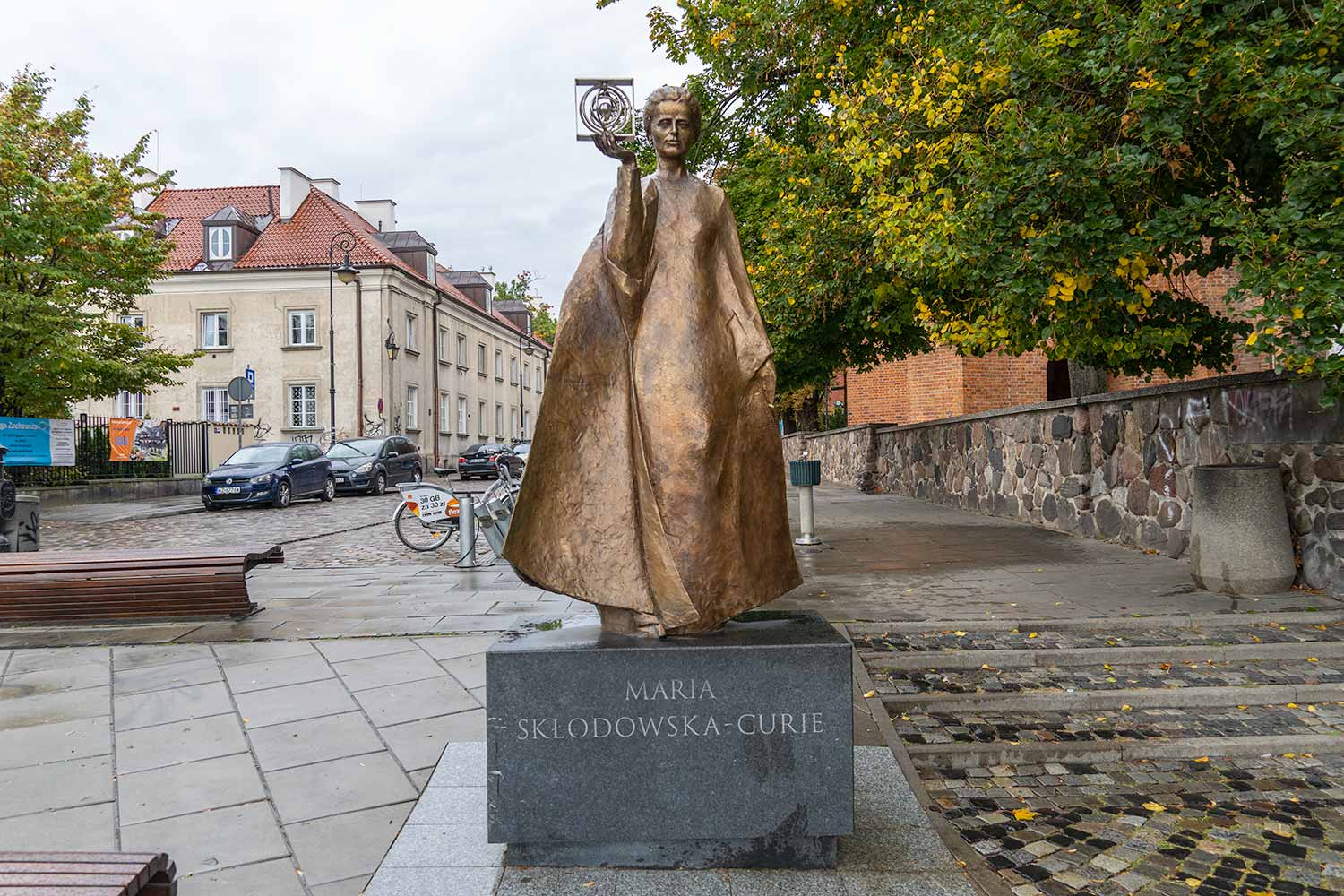 Maria Skłodowska Curie Monument: Maria Skłodowska was born in Warsaw. Most people know her as Marie Curie after her marriage to physicist Pierre Curie.
Maria Skłodowska Curie Monument: Maria Skłodowska was born in Warsaw. Most people know her as Marie Curie after her marriage to physicist Pierre Curie.
Not only was she the first woman to win the Nobel Prize, but she was also the first scientist in history to win 2 Nobel Prizes (in Physics and Chemistry). As one of only four scientists to have won two Nobel Prizes, Maria Skłodowska Curie stands among some of the greatest scientists of all time. Understandably, she is widely-revered in Poland, and there are many monuments of her scattered throughout Warsaw. This is one of the major ones.
Cost: Free to Visit. Recommended Duration of Visit: 5 – 10 minutes.
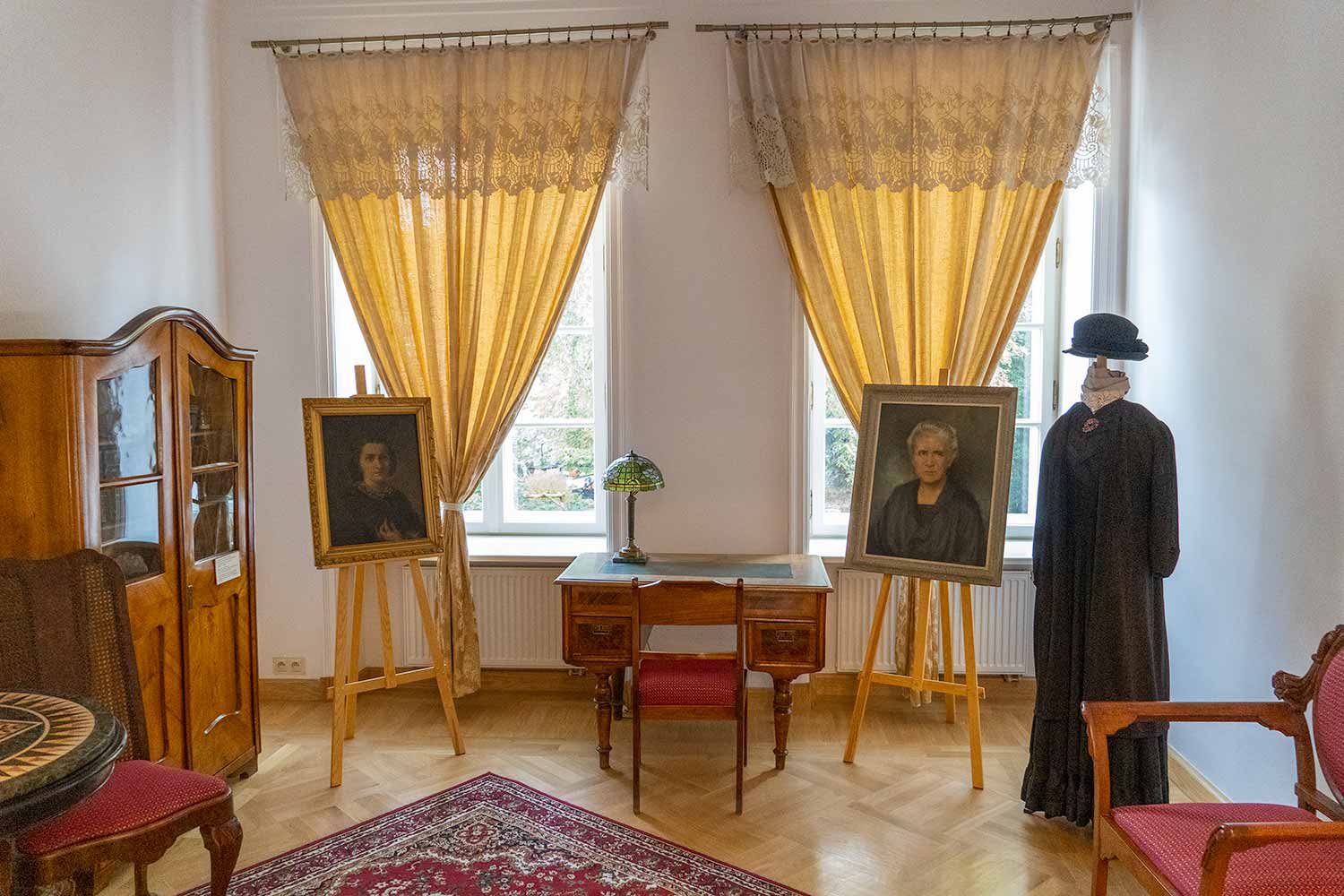 Maria Skłodowska Curie Museum: Since Maria Skłodowska Curie is a national treasure, the Polish are very proud to display her achievements.
Maria Skłodowska Curie Museum: Since Maria Skłodowska Curie is a national treasure, the Polish are very proud to display her achievements.
This museum—dedicated to the famous scientist’s life and work— is very special, because it is the house in which she was born. The museum is biographical in nature, with many exhibits comprised of photographs, documents, and letters, among others.
For more information, refer to my post about the Maria Skłodowska Curie Museum. It contains more detail and history.
Cost: 6 – 10 PLN (cheaper for students). Recommended Duration of Visit: 1 – 2 hours.
| This monument is one of the furthest attractions north of Warsaw. As a bonus, it is right next to a nice park within the historic Warsaw New Town region. |
| The original building is on 16 Freta Street. Due to renovations, the museum might have been moved to a nearby building. The museum is a short walk from the monument. |
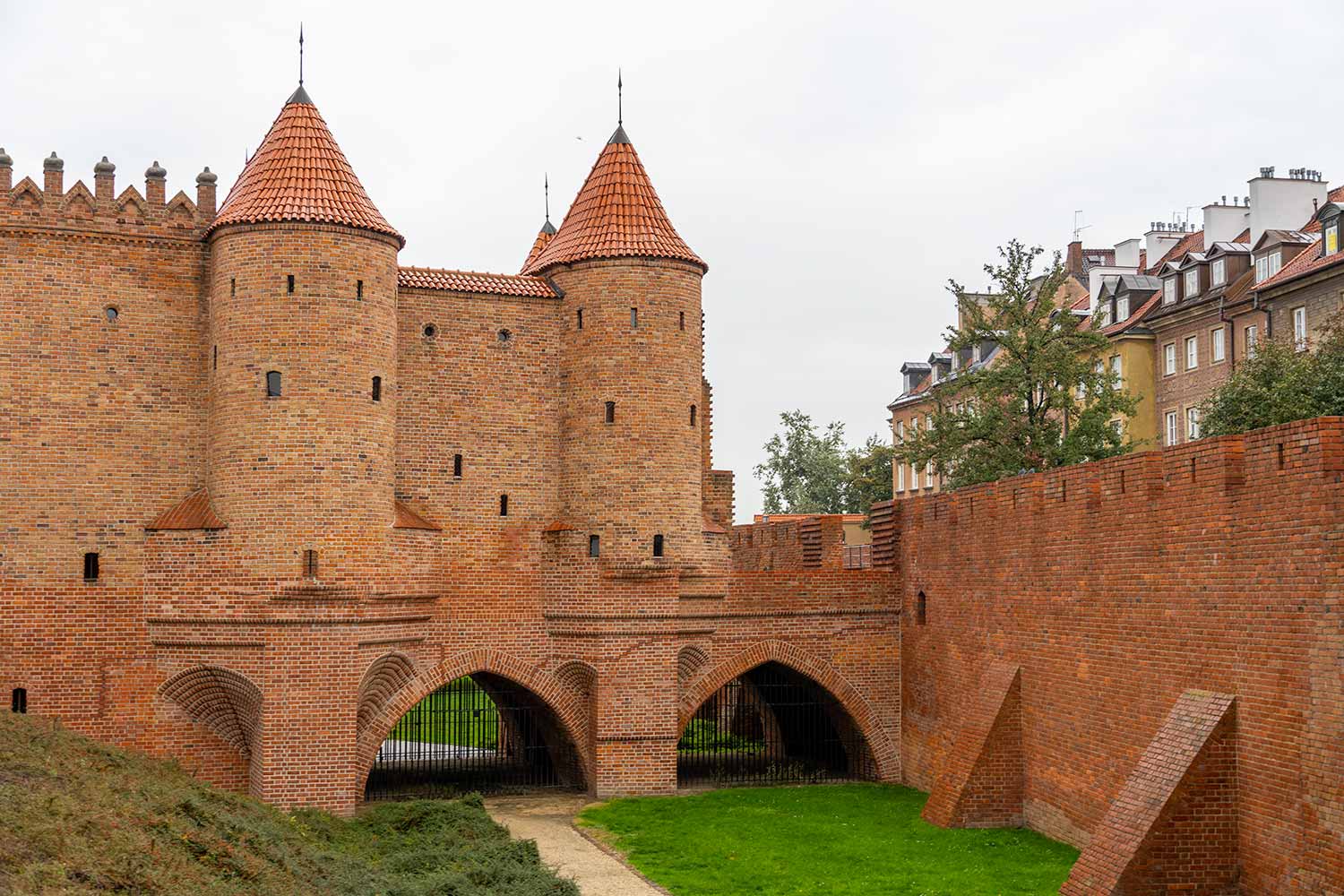 Warsaw Barbican: The barbican—the outer defense of a castle or city—was erected in 1540. The original barbican was actually destroyed during World War II. After the war, the new barbican was constructed mostly as a tourist attraction.
Warsaw Barbican: The barbican—the outer defense of a castle or city—was erected in 1540. The original barbican was actually destroyed during World War II. After the war, the new barbican was constructed mostly as a tourist attraction.
Cost: Free to visit. Recommended Duration of Visit: 15 – 30 minutes.
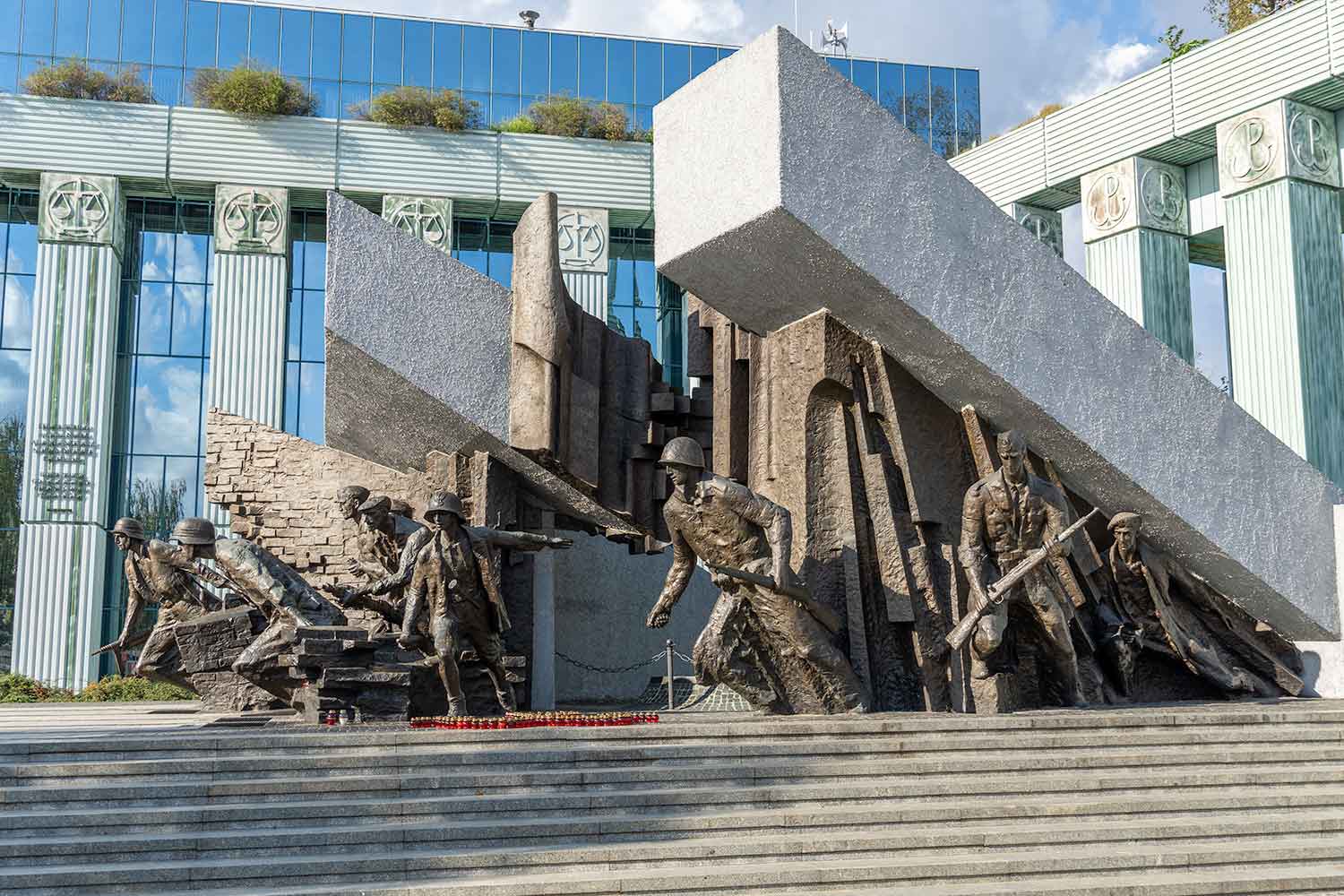 Warsaw Uprising Monument: As one of the most important monuments in Warsaw, it commemorates one of the most important events in Warsaw—the Warsaw Uprising of 1944.
Warsaw Uprising Monument: As one of the most important monuments in Warsaw, it commemorates one of the most important events in Warsaw—the Warsaw Uprising of 1944.
The uprising was the Polish underground resistance’s attempt to free Warsaw from German occupation. Over the span of 63 days, despite fighting valiantly without outside support, the resistance was suppressed by the Germans. Many historians believed that the Soviets halted their nearby forces to let the uprising fail. By 1945, over 80% of Warsaw was destroyed. The monument is so integral to Polish history that foreign presidents often visit it.
Cost: Free to visit. Recommended Duration of Visit: 10 – 15 minutes.
| The barbican is located in an area densely populated with many restaurants and cafes. It is also a very short distance away from central Warsaw. |
| The monument is near a very nice park with a palace (Krasinski Palace) near the edge. There is also a very cool bench nearby (Ławeczka Chopina - 9. Plac Krasińskich) that plays music. |
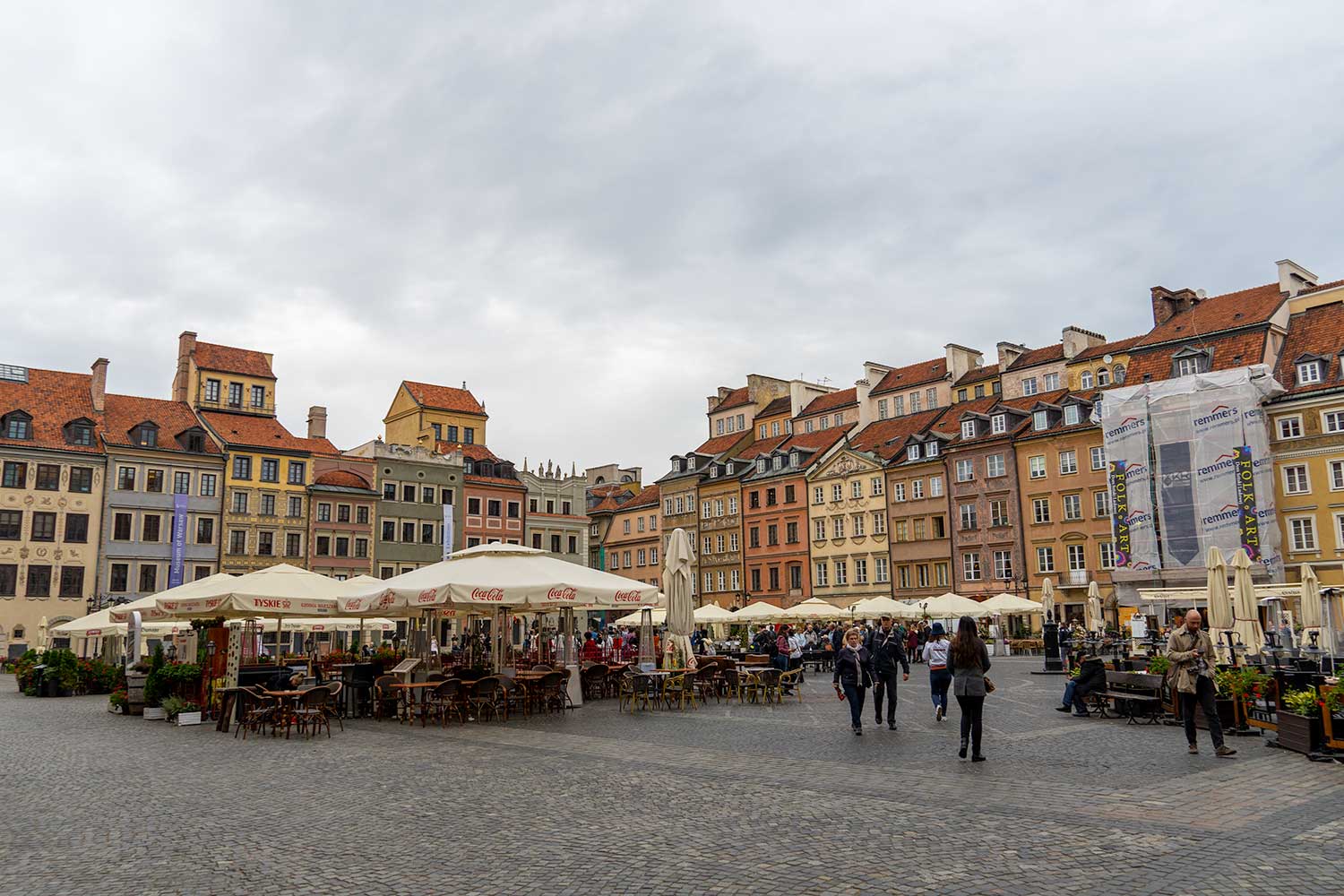 Old Town Market Square: Warsaw Old Town, established in the 13th century, is the oldest part of the city, and Old Town Market Square is the most festive part of the region. The market square is filled with beautiful architecture, shops, restaurants, cafes, and tourist attractions.
Old Town Market Square: Warsaw Old Town, established in the 13th century, is the oldest part of the city, and Old Town Market Square is the most festive part of the region. The market square is filled with beautiful architecture, shops, restaurants, cafes, and tourist attractions.
The original Old Town was mostly destroyed during World War II, so many of the current structures were constructed during the post-war era. Incredibly, the buildings were recreated while referring mostly to paintings and photographs.
Cost: Free to visit. Recommended Duration of Visit: 30 minutes – 2 hours.
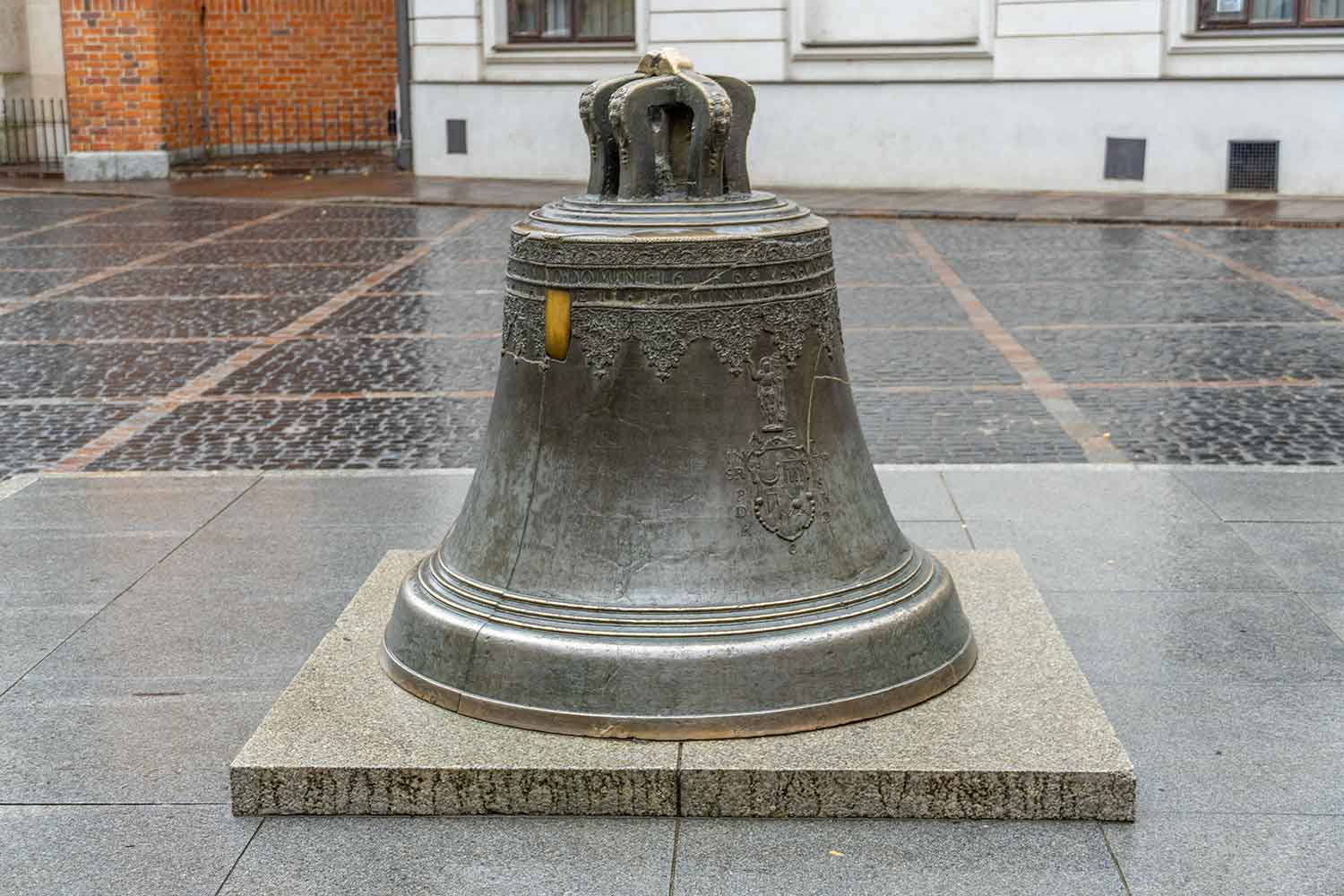 The Wishing Bell: The Wishing Bell, made in the 17th century, is all that remains of a tragic fairytale. Kajetan, a young bellmaker, was in love with Marynia, the daughter of a retired bellmaker.
The Wishing Bell: The Wishing Bell, made in the 17th century, is all that remains of a tragic fairytale. Kajetan, a young bellmaker, was in love with Marynia, the daughter of a retired bellmaker.
The two planned to get married. However, Hans, a jealous rival, poisoned Kajetan’s wine, and Kajetan died the moment the newly-created bell was rung. Marynia was so heartbroken that she joined a convent, and Hans eventually went mad and committed suicide.
Legend says that, if you walk around the bell three times (preferably while touching it), you can make a wish and it might come true. Alternatively, you can bang your head against it three times and make a wish.
Cost: Free to visit. Recommended Duration of Visit: 1 – 5 minutes.
| The Old Town Market Square is a great first destination for your itinerary. You can easily spend several hours here, and walking in any direction will lead you to an incredible attraction. |
| The Wishing Bell is a short distance southeast of Old Town Market Square. Also, I was just kidding about banging your head three times (just once is fine). All kidding aside, don’t do that. |
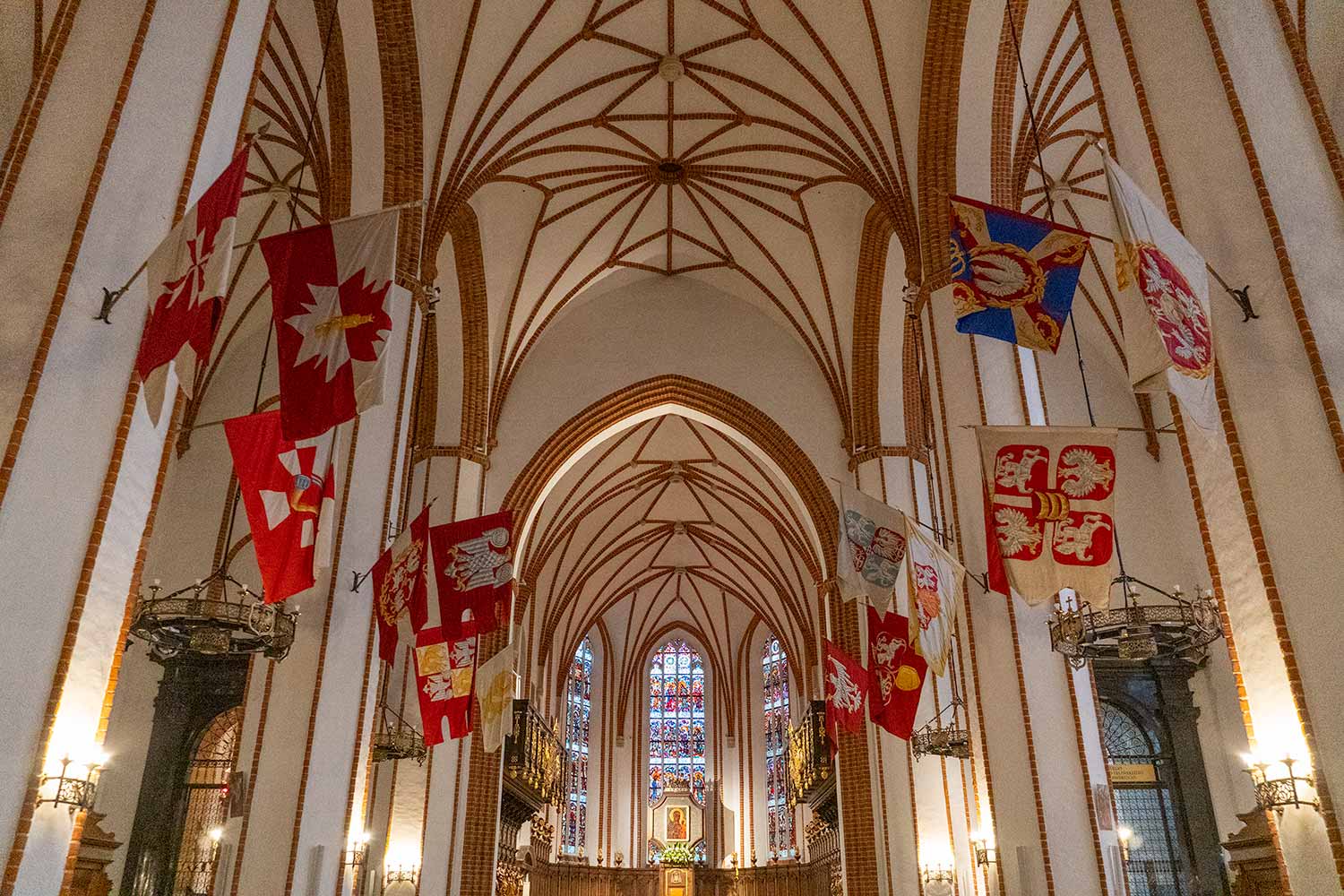 St. John’s Cathedral (Bazylika Archikatedralna): St. John’s Cathedral, located in central Warsaw, is one of the most recognizable sites in the city. The interior of this massive Roman Catholic church is striking, leaving one in awe of its unique architectural design and sheer vastness.
St. John’s Cathedral (Bazylika Archikatedralna): St. John’s Cathedral, located in central Warsaw, is one of the most recognizable sites in the city. The interior of this massive Roman Catholic church is striking, leaving one in awe of its unique architectural design and sheer vastness.
Cost: Free to visit. Recommended Duration of Visit: 30 – 60 minutes.
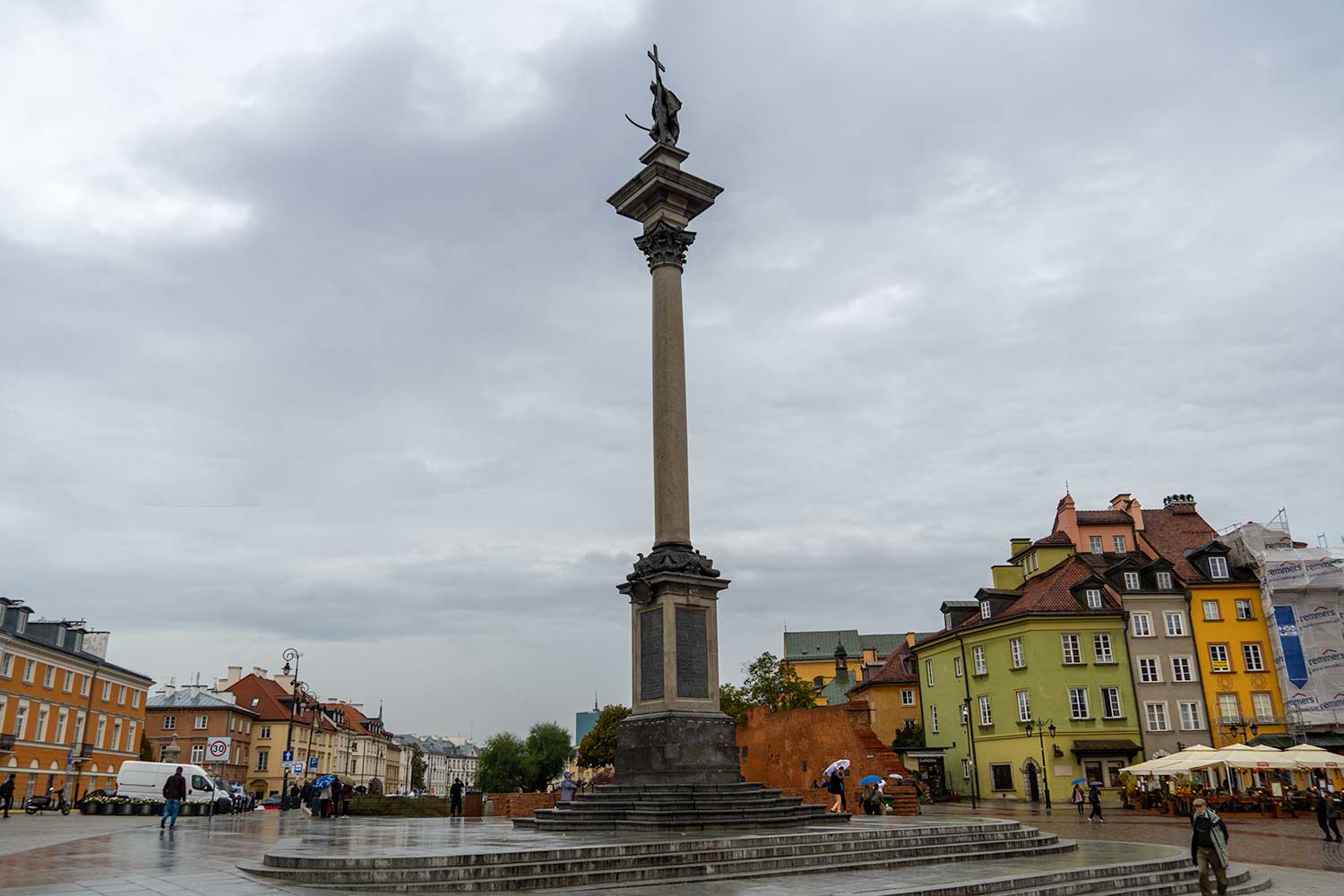 Sigismund’s Column: This monument, erected in 1644, stands in the middle of Castle Square. As one of Warsaw’s most famous landmarks, the column and statue commemorate king Sigismund III. The column is 28 feet (8.5 meters) and the statue is 9 feet (2.75 meters).
Sigismund’s Column: This monument, erected in 1644, stands in the middle of Castle Square. As one of Warsaw’s most famous landmarks, the column and statue commemorate king Sigismund III. The column is 28 feet (8.5 meters) and the statue is 9 feet (2.75 meters).
Cost: Free to visit. Recommended Duration of Visit: 5 – 30 minutes (the surrounding area is quite festive).
| The archcathedral is close to several other churches (St. Martin’s Church and Shrine of Our Lady of Grace) as well. The archcathedral is also a short distance from the Wishing Bell. |
| Sigismund’s Column is occasionally the gathering place of many tour groups. You might find a tour guide (around 10 am to 12 pm) who can show you around Warsaw. |
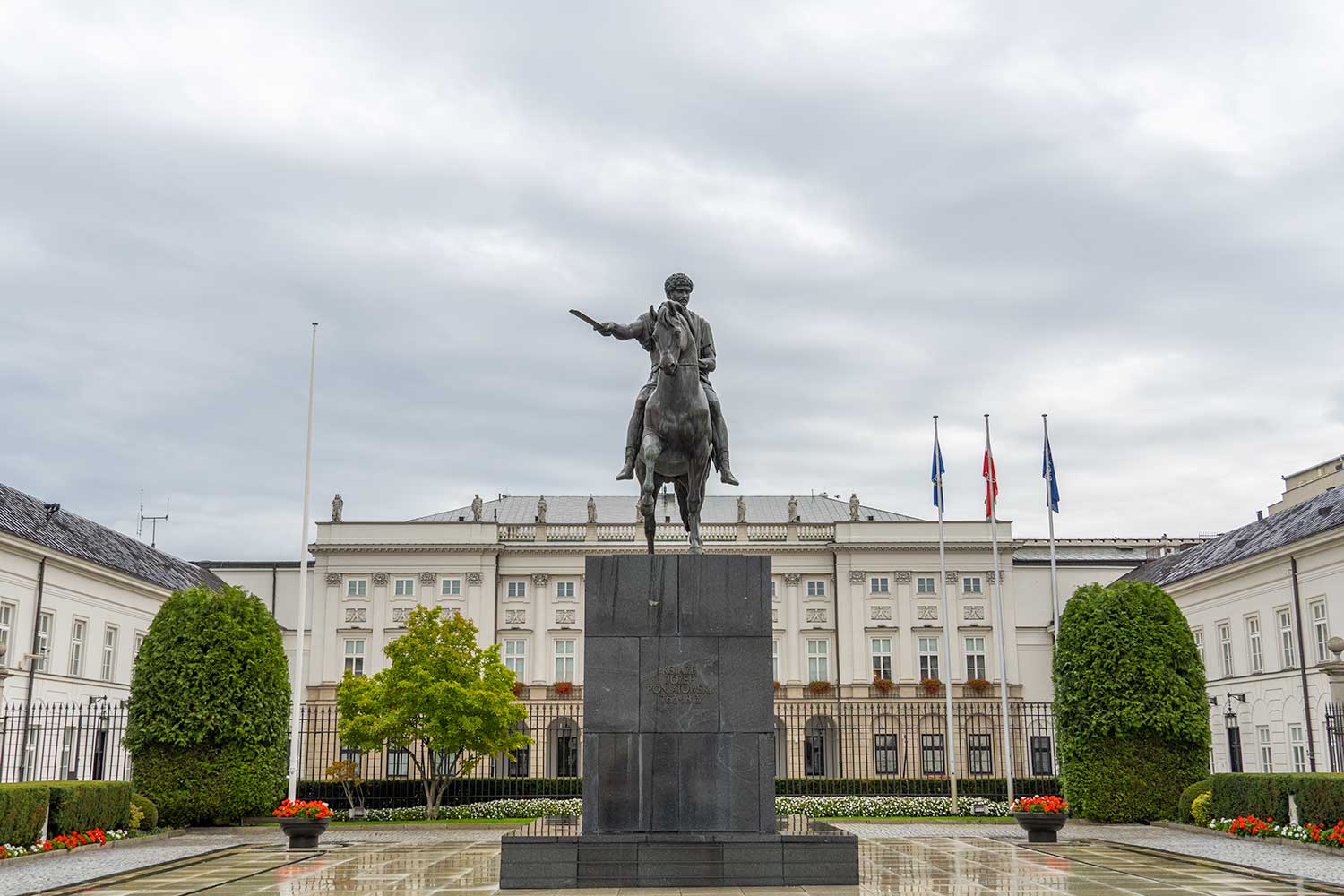 Presidential Palace: The Presidential Palace, constructed in 1643, is home to Poland’s President. Despite being rebuilt and remodeled throughout history, the palace still features exquisite neoclassical architecture and history.
Presidential Palace: The Presidential Palace, constructed in 1643, is home to Poland’s President. Despite being rebuilt and remodeled throughout history, the palace still features exquisite neoclassical architecture and history.
Cost: You can only enter the palace on a guided tour. For more information, refer to the official Presidential Palace website. Recommended Duration of Visit: 5 minutes – 2 hours.
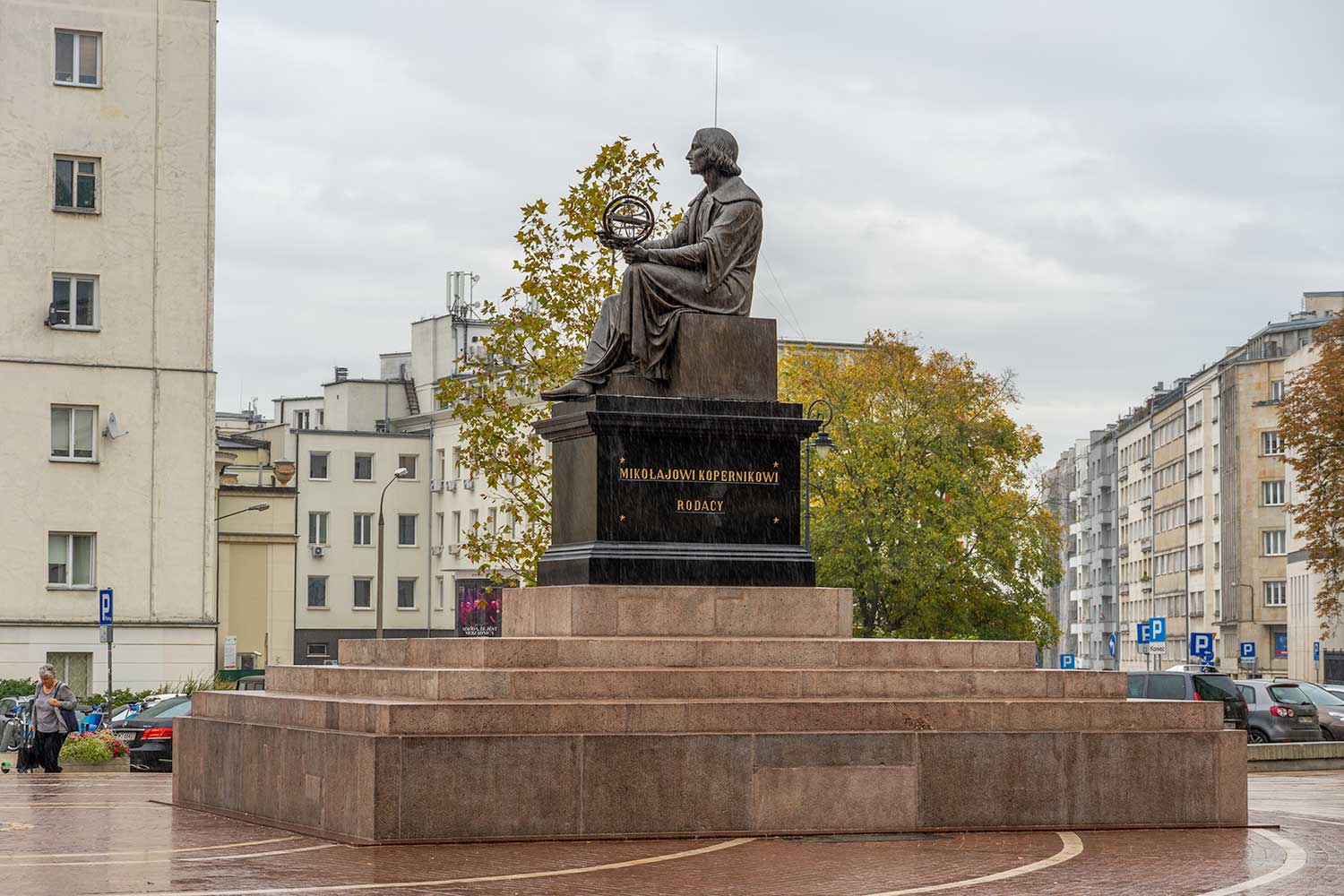 Nicholas Copernicus Monument: The Polish astronomer Nicolaus Copernicus is widely recognized for the heliocentric theory that placed the sun rather than the Earth at the center of the universe.
Nicholas Copernicus Monument: The Polish astronomer Nicolaus Copernicus is widely recognized for the heliocentric theory that placed the sun rather than the Earth at the center of the universe.
He was both a polymath (an individual with expertise in many subjects) and a polyglot (an individual who knows multiple languages). Before his death, he published On the Revolutions of the Celestial Spheres—a book that pioneered contributions to the scientific revolution. The statue depicts the astronomer holding a compass and armillary sphere.
Cost: Free to visit. Recommended Duration of Visit: 5 – 10 minutes.
| Scheduling a guided tour on the website is actually quite a pain if you are only in the city for a few days. It’s best to find a general tour guide and see if they can get you in. |
| The monument is located near Nowy Świat—a street with many restaurants, bars, shops, and cafes, among others. Nowy Świat is the main commercial artery of Warsaw. |
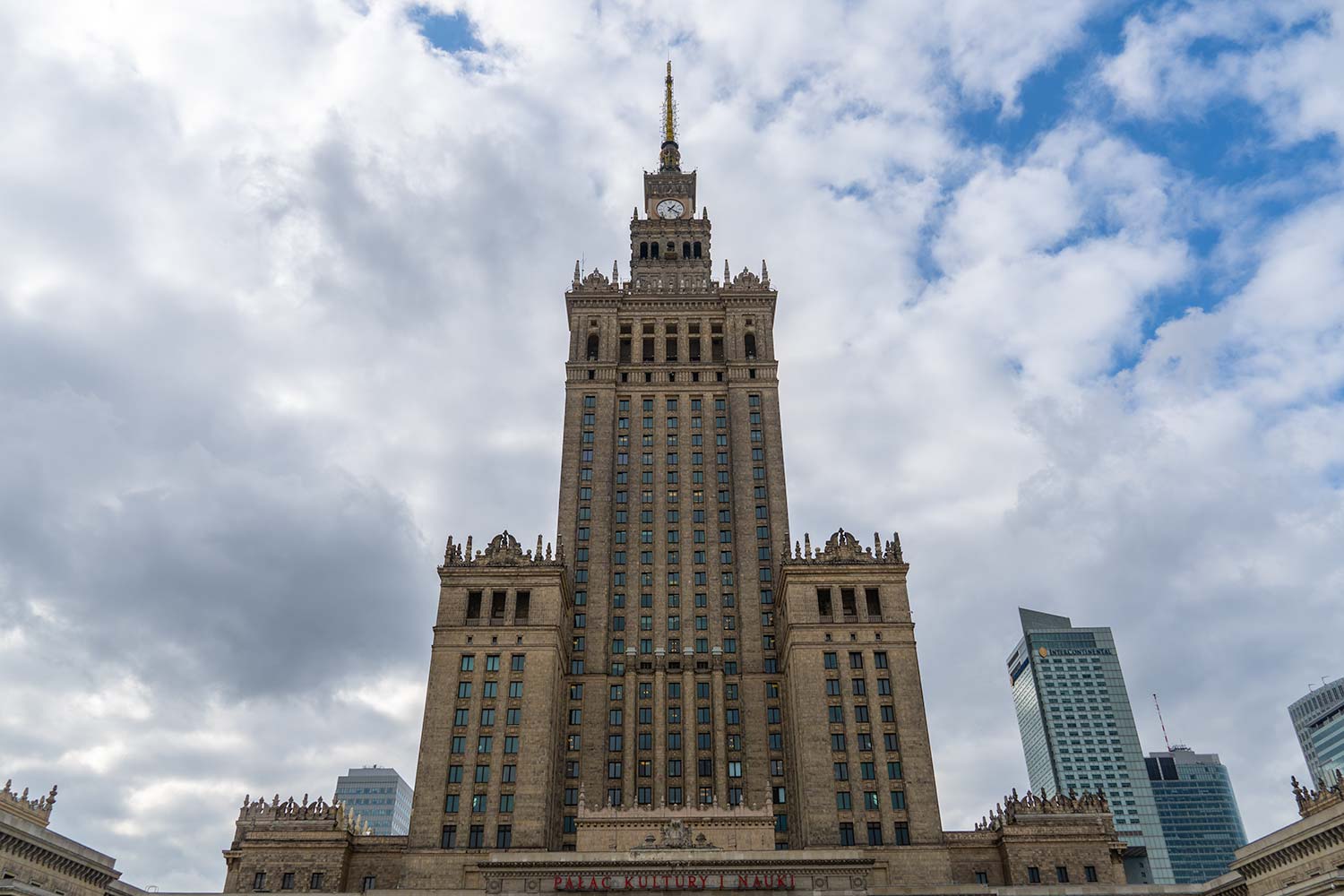 Palace of Culture and Science: At 778 feet (237 meters), the Palace of Culture and Science is one of the tallest structures in Europe. It houses cultural institutions such as theaters, cinemas, museums, cafes, and libraries, among others. As a bonus, the observation deck provides a breathtaking panoramic view of the city.
Palace of Culture and Science: At 778 feet (237 meters), the Palace of Culture and Science is one of the tallest structures in Europe. It houses cultural institutions such as theaters, cinemas, museums, cafes, and libraries, among others. As a bonus, the observation deck provides a breathtaking panoramic view of the city.
Cost: About 20 PLN when I visited in 2019. Refer to the Palace of Culture and Science page for more information. Recommended Duration of Visit: 1 – 2 hours.
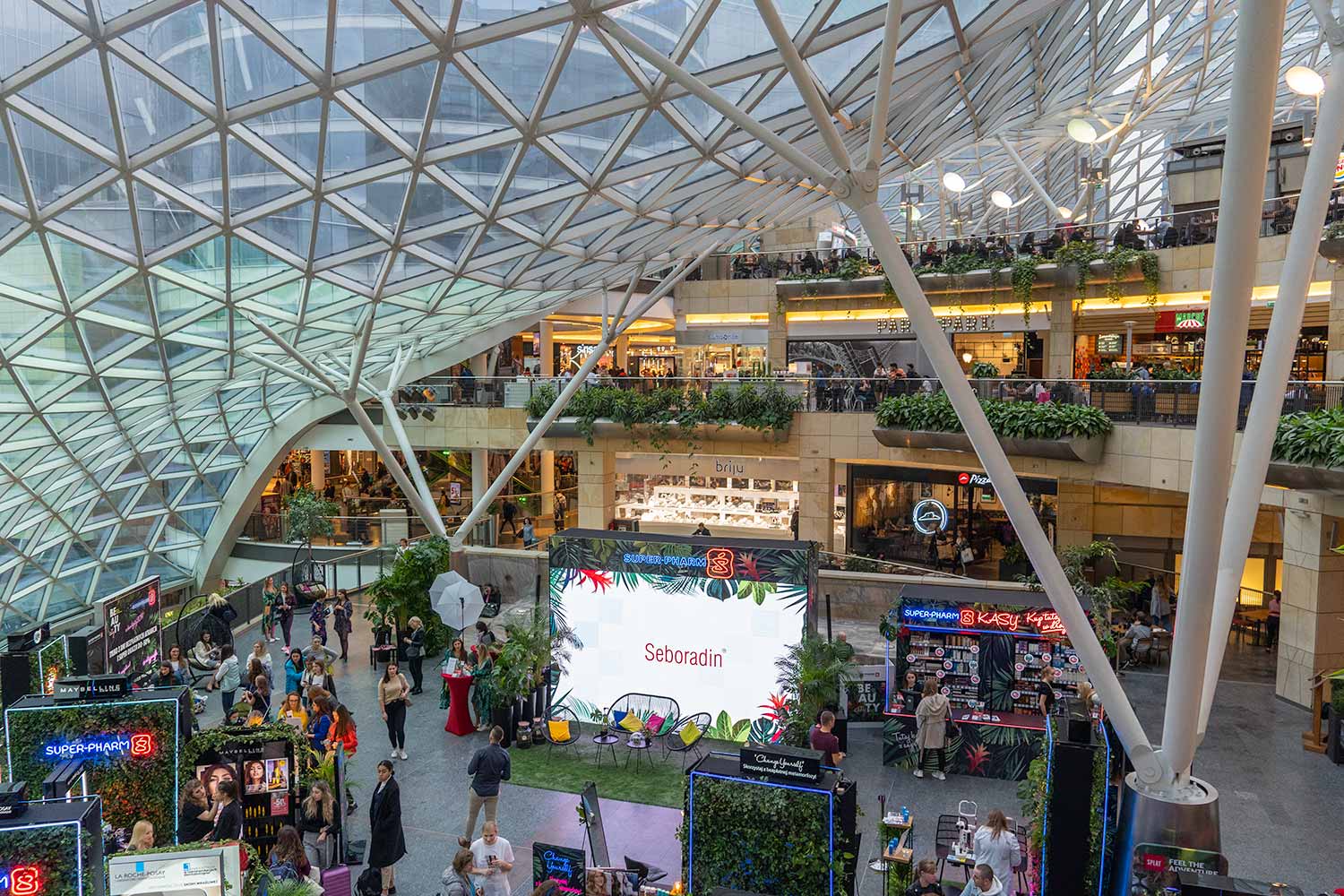 Złote Tarasy: Złote Tarasy, most recognized for its transparant flowing blue domes, is a shopping mall and the main commercial and entertainment complex in Warsaw.
Złote Tarasy: Złote Tarasy, most recognized for its transparant flowing blue domes, is a shopping mall and the main commercial and entertainment complex in Warsaw.
This mall includes over 200 shops and restaurants, a hotel, and a cinema, among others. This place is very fun to visit, and there are always plenty of things to do. If you are curious what the locals are like, then this place is perfect because it is the central hub of activity.
Cost: Free to visit. Recommended Duration of Visit: 1 – 2 hours.
| There are many interesting and free exhibits in the palace. Occasionally, there are very cool car displays outside. |
| Złote Tarasy is within short walking distance of the Palace of Culture and Science. |
 Palace on the Isle: Deep within beautiful Łazienki Park (a.k.a. Royal Baths Park) and at the center of a lake lies the Palace on the Isle—a classicist 18th-century palace. For clarification, classicism art essentially focuses on art from the Classical Period (from 8th century BC to 6th century BC). Throughout the palace, you will find an abundance of art pieces and sculptures from ancient Greece and Rome.
Palace on the Isle: Deep within beautiful Łazienki Park (a.k.a. Royal Baths Park) and at the center of a lake lies the Palace on the Isle—a classicist 18th-century palace. For clarification, classicism art essentially focuses on art from the Classical Period (from 8th century BC to 6th century BC). Throughout the palace, you will find an abundance of art pieces and sculptures from ancient Greece and Rome.
Cost: About 25 PLN when I visited in 2019. Recommended Duration of Visit: 1 – 2 hours.
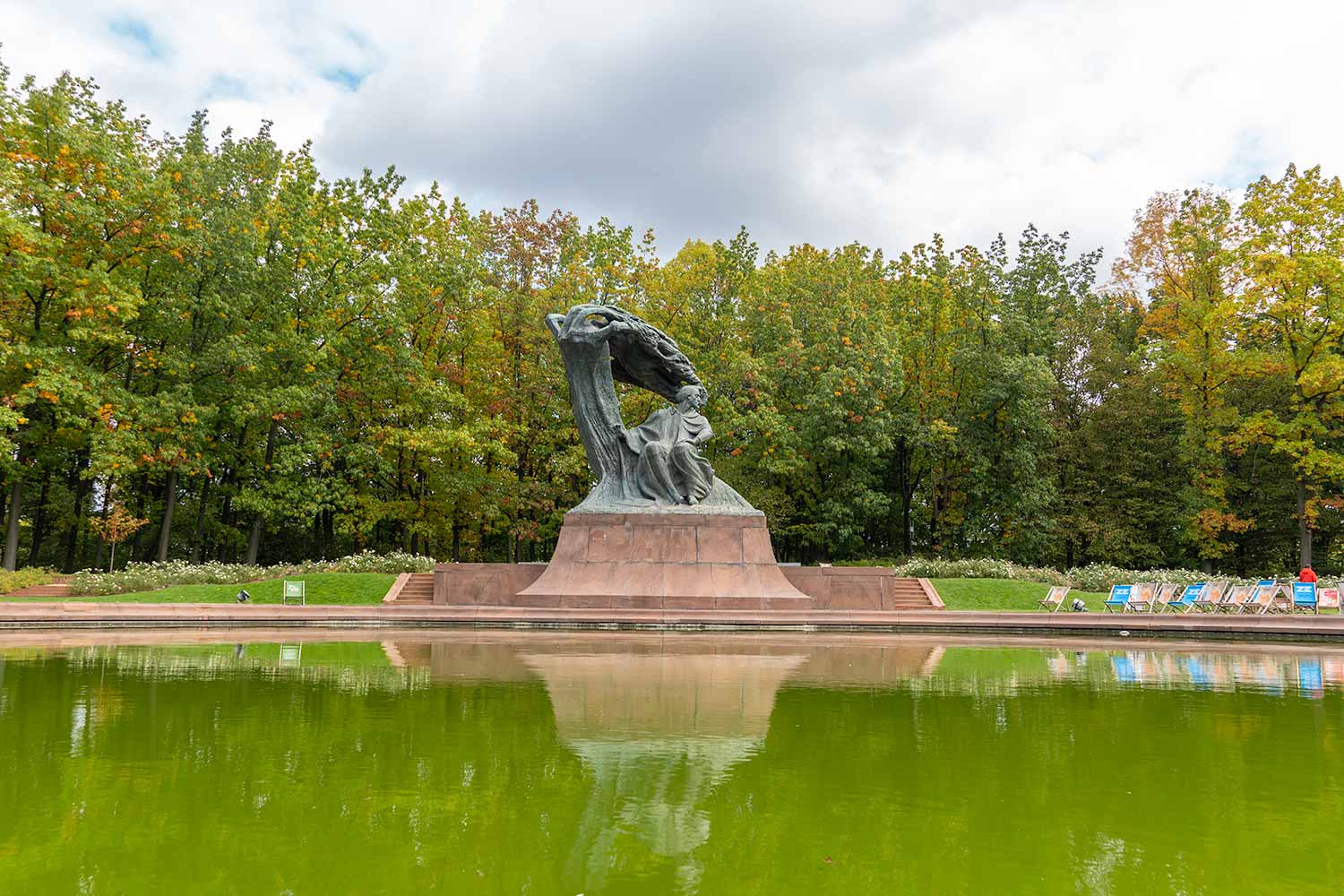 Chopin Monument: Frédéric Chopin was a world-renowned composer and pianist. It was said that Chopin was without equal in his generation. His monument lies at the edge of a beautiful pond toward the left edge of Łazienki Park. It is very likely that you have heard of his music (i.e. Nocturne op.9 No.2).
Chopin Monument: Frédéric Chopin was a world-renowned composer and pianist. It was said that Chopin was without equal in his generation. His monument lies at the edge of a beautiful pond toward the left edge of Łazienki Park. It is very likely that you have heard of his music (i.e. Nocturne op.9 No.2).
Cost: Free to visit. Recommended Duration of Visit: 15 – 30 minutes.
| Łazienki Park is the largest park in the entire city, and you can easily spend hours here. It is absolutely stunning and features plenty of nature, scenic walking trails, a museum, a botanical garden, an an art gallery, among others. |
| Throughout Warsaw, there are many concert halls dedicated to the work of Chopin. For instance, Chopin Point is a popular concert hall. His music, life, and early death (he died at 39) made him a symbol of the Romantic era. |
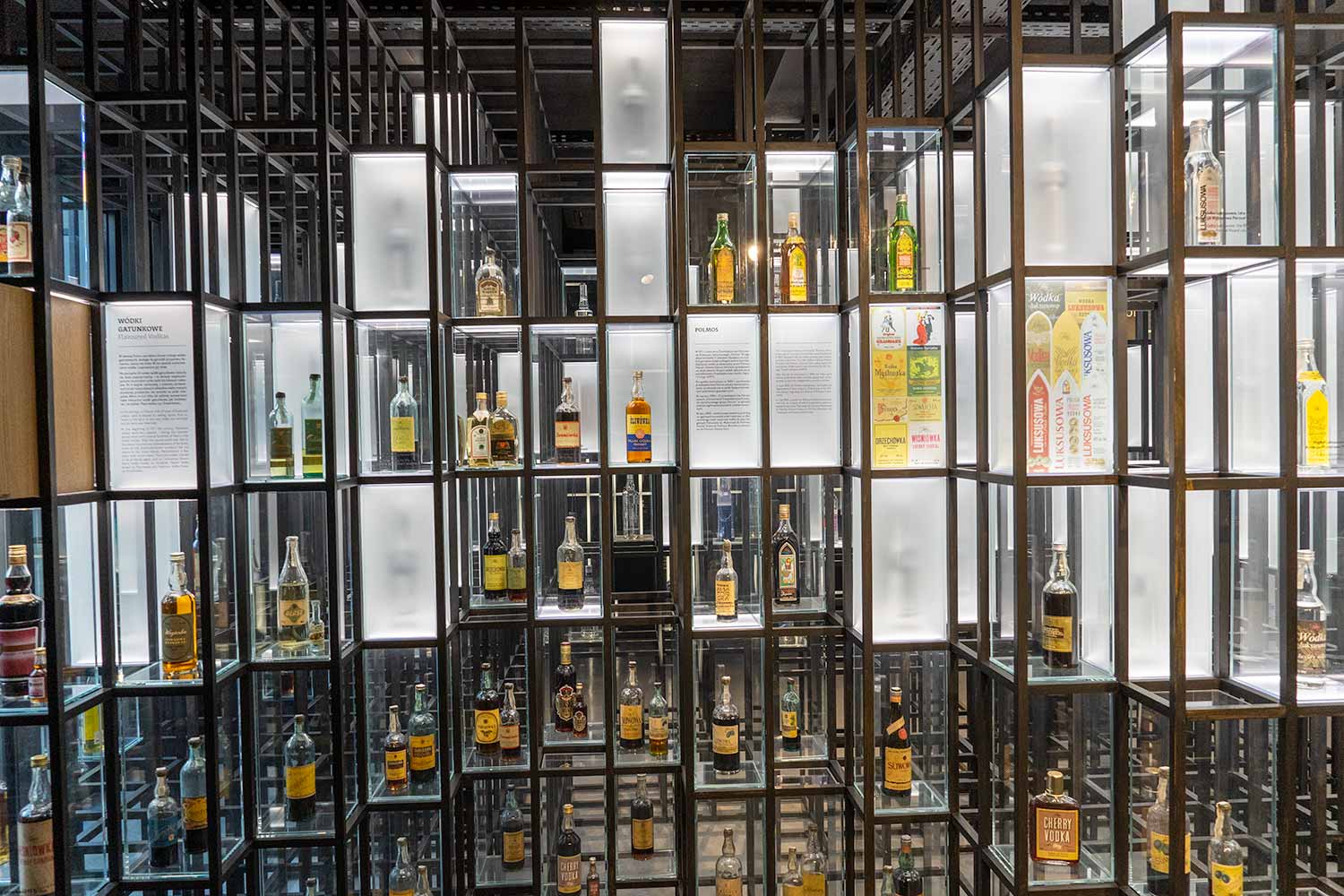 Polish Vodka Museum (Muzeum Polskiej Wódki): The Polish Vodka Museum is a hidden gem in Warsaw (mostly because it is toward the outskirts).
Polish Vodka Museum (Muzeum Polskiej Wódki): The Polish Vodka Museum is a hidden gem in Warsaw (mostly because it is toward the outskirts).
The museum is elaborate and the tour—comprised of a short film, some history, and interactive displays—was entertaining from the beginning to end. And yes, you can taste some vodka at the end of the tour.
Cost: 45 PLN. Recommended Duration of Visit: The tour is approximately 45 minutes.
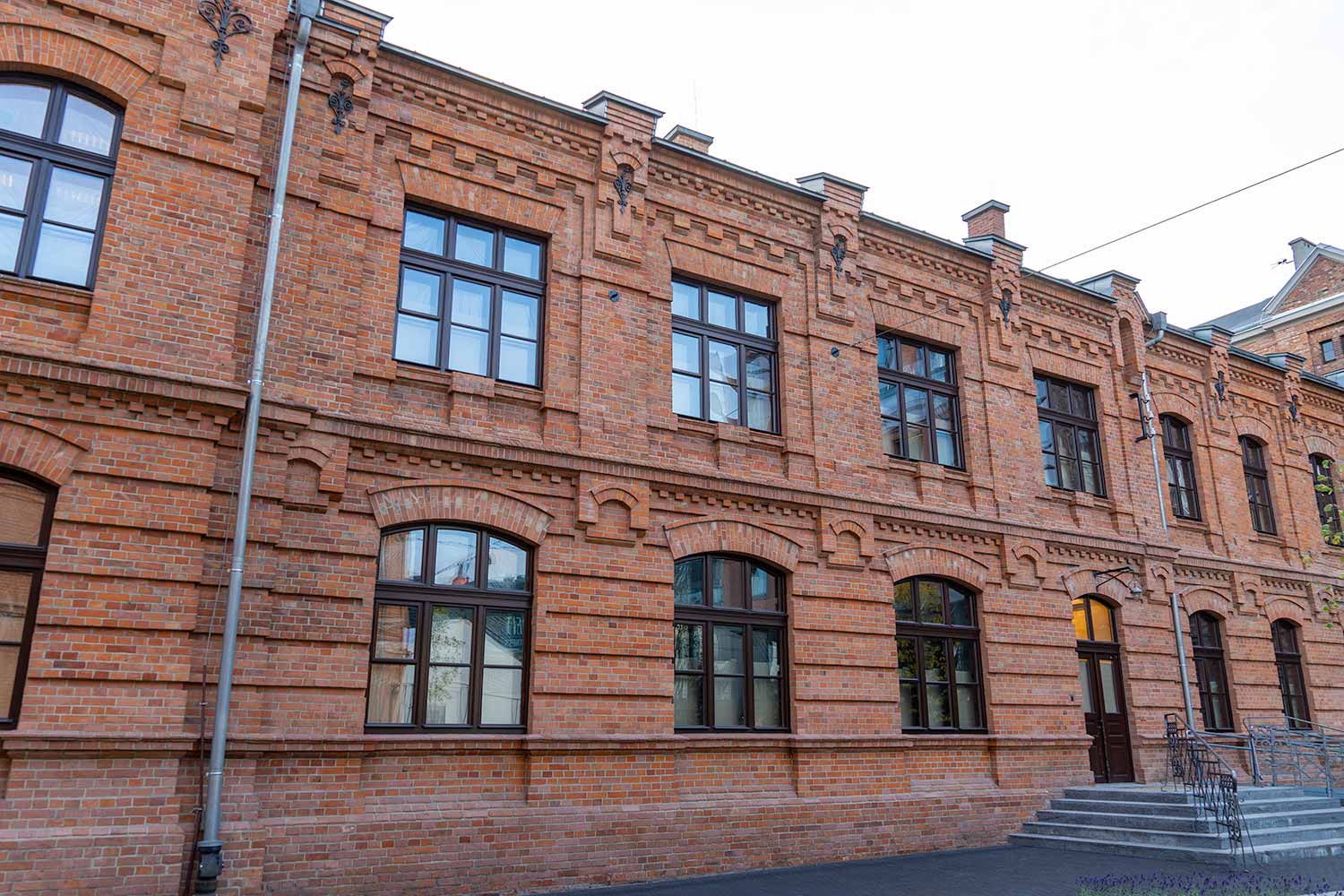 Praga: This district in Warsaw lies on the east bank of the Vistula River. The beautiful architecture in Praga is distinct from western Warsaw (west of the river). Praga’s history dates back to the 15th century, and some of the buildings are a representation of what Poland sort of looked like before World War II.
Praga: This district in Warsaw lies on the east bank of the Vistula River. The beautiful architecture in Praga is distinct from western Warsaw (west of the river). Praga’s history dates back to the 15th century, and some of the buildings are a representation of what Poland sort of looked like before World War II.
Cost: Free to Visit. Recommended Duration of Visit: 1 – 2 hours.
| This museum is near Praga (across the river and on the right side of Warsaw). Do not confuse it with the “Museum of Vodka” near central warsaw. |
| If you’re feeling adventurous and have some time, walking to Praga takes approximately 40 minutes from central Warsaw. The scenery, especially as you cross the Vistula River, is incredible. |
Attractions are paired up based on similarity and/or proximity. All the names provided are easily searchable on Google Maps.
 Maria Skłodowska Curie Monument: Maria Skłodowska was born in Warsaw. Most people know her as Marie Curie after her marriage to physicist Pierre Curie.
Maria Skłodowska Curie Monument: Maria Skłodowska was born in Warsaw. Most people know her as Marie Curie after her marriage to physicist Pierre Curie.
Not only was she the first woman to win the Nobel Prize, but she was also the first scientist in history to win 2 Nobel Prizes (in Physics and Chemistry). As one of only four scientists to have won two Nobel Prizes, Maria Skłodowska Curie stands among some of the greatest scientists of all time. Understandably, she is widely-revered in Poland, and there are many monuments of her scattered throughout Warsaw. This is one of the major ones.
Cost: Free to Visit. Recommended Duration of Visit: 5 – 10 minutes.
| This monument is one of the furthest attractions north of Warsaw. As a bonus, it is right next to a nice park within the historic Warsaw New Town region. |
 Maria Skłodowska Curie Museum: Since Maria Skłodowska Curie is a national treasure, the Polish are very proud to display her achievements.
Maria Skłodowska Curie Museum: Since Maria Skłodowska Curie is a national treasure, the Polish are very proud to display her achievements.
This museum—dedicated to the famous scientist’s life and work— is very special, because it is the house in which she was born. The museum is biographical in nature, with many exhibits comprised of photographs, documents, and letters, among others.
For more information, refer to my post about the Maria Skłodowska Curie Museum. It contains more detail and history.
Cost: 6 – 10 PLN (cheaper for students). Recommended Duration of Visit: 1 – 2 hours.
| The original building is on 16 Freta Street. Due to renovations, the museum might have been moved to a nearby building. The museum is a short walk from the monument. |
 Warsaw Barbican: The barbican—the outer defense of a castle or city—was erected in 1540. The original barbican was actually destroyed during World War II. After the war, the new barbican was constructed mostly as a tourist attraction.
Warsaw Barbican: The barbican—the outer defense of a castle or city—was erected in 1540. The original barbican was actually destroyed during World War II. After the war, the new barbican was constructed mostly as a tourist attraction.
Cost: Free to visit. Recommended Duration of Visit: 15 – 30 minutes.
| The barbican is located in an area densely populated with many restaurants and cafes. It is also a very short distance away from central Warsaw. |
 Warsaw Uprising Monument: As one of the most important monuments in Warsaw, it commemorates one of the most important events in Warsaw—the Warsaw Uprising of 1944.
Warsaw Uprising Monument: As one of the most important monuments in Warsaw, it commemorates one of the most important events in Warsaw—the Warsaw Uprising of 1944.
The uprising was the Polish underground resistance’s attempt to free Warsaw from German occupation. Over the span of 63 days, despite fighting valiantly without outside support, the resistance was suppressed by the Germans. Many historians believed that the Soviets halted their nearby forces to let the uprising fail. By 1945, over 80% of Warsaw was destroyed. The monument is so integral to Polish history that foreign presidents often visit it.
Cost: Free to visit. Recommended Duration of Visit: 10 – 15 minutes.
| The monument is near a very nice park with a palace (Krasinski Palace) near the edge. There is also a very cool bench nearby (Ławeczka Chopina - 9. Plac Krasińskich) that plays music. |
 Old Town Market Square: Warsaw Old Town, established in the 13th century, is the oldest part of the city, and Old Town Market Square is the most festive part of the region. The market square is filled with beautiful architecture, shops, restaurants, cafes, and tourist attractions.
Old Town Market Square: Warsaw Old Town, established in the 13th century, is the oldest part of the city, and Old Town Market Square is the most festive part of the region. The market square is filled with beautiful architecture, shops, restaurants, cafes, and tourist attractions.
The original Old Town was mostly destroyed during World War II, so many of the current structures were constructed during the post-war era. Incredibly, the buildings were recreated while referring mostly to paintings and photographs.
Cost: Free to visit. Recommended Duration of Visit: 30 minutes – 2 hours.
| The Old Town Market Square is a great first destination for your itinerary. You can easily spend several hours here, and walking in any direction will lead you to an incredible attraction. |
 The Wishing Bell: The Wishing Bell, made in the 17th century, is all that remains of a tragic fairytale. Kajetan, a young bellmaker, was in love with Marynia, the daughter of a retired bellmaker.
The Wishing Bell: The Wishing Bell, made in the 17th century, is all that remains of a tragic fairytale. Kajetan, a young bellmaker, was in love with Marynia, the daughter of a retired bellmaker.
The two planned to get married. However, Hans, a jealous rival, poisoned Kajetan’s wine, and Kajetan died the moment the newly-created bell was rung. Marynia was so heartbroken that she joined a convent, and Hans eventually went mad and committed suicide.
Legend says that, if you walk around the bell three times (preferably while touching it), you can make a wish and it might come true. Alternatively, you can bang your head against it three times and make a wish.
Cost: Free to visit. Recommended Duration of Visit: 1 – 5 minutes.
| The Wishing Bell is a short distance southeast of Old Town Market Square. Also, I was just kidding about banging your head three times (just once is fine). All kidding aside, don’t do that. |
 St. John’s Cathedral (Bazylika Archikatedralna): St. John’s Cathedral, located in central Warsaw, is one of the most recognizable sites in the city. The interior of this massive Roman Catholic church is striking, leaving one in awe of its unique architectural design and sheer vastness.
St. John’s Cathedral (Bazylika Archikatedralna): St. John’s Cathedral, located in central Warsaw, is one of the most recognizable sites in the city. The interior of this massive Roman Catholic church is striking, leaving one in awe of its unique architectural design and sheer vastness.
Cost: Free to visit. Recommended Duration of Visit: 30 – 60 minutes.
| The archcathedral is close to several other churches (St. Martin’s Church and Shrine of Our Lady of Grace) as well. The archcathedral is also a short distance from the Wishing Bell. |
 Sigismund’s Column: This monument, erected in 1644, stands in the middle of Castle Square. As one of Warsaw’s most famous landmarks, the column and statue commemorate king Sigismund III. The column is 28 feet (8.5 meters) and the statue is 9 feet (2.75 meters).
Sigismund’s Column: This monument, erected in 1644, stands in the middle of Castle Square. As one of Warsaw’s most famous landmarks, the column and statue commemorate king Sigismund III. The column is 28 feet (8.5 meters) and the statue is 9 feet (2.75 meters).
Cost: Free to visit. Recommended Duration of Visit: 5 – 30 minutes (the surrounding area is quite festive).
| Sigismund’s Column is occasionally the gathering place of many tour groups. You might find a tour guide (around 10 am to 12 pm) who can show you around Warsaw. |
 Presidential Palace: The Presidential Palace, constructed in 1643, is home to Poland’s President. Despite being rebuilt and remodeled throughout history, the palace still features exquisite neoclassical architecture and history.
Presidential Palace: The Presidential Palace, constructed in 1643, is home to Poland’s President. Despite being rebuilt and remodeled throughout history, the palace still features exquisite neoclassical architecture and history.
Cost: You can only enter the palace on a guided tour. For more information, refer to the official Presidential Palace website. Recommended Duration of Visit: 5 minutes – 2 hours.
| Scheduling a guided tour on the website is actually quite a pain if you are only in the city for a few days. It’s best to find a general tour guide and see if they can get you in. |
 Nicholas Copernicus Monument: The Polish astronomer Nicolaus Copernicus is widely recognized for the heliocentric theory that placed the sun rather than the Earth at the center of the universe.
Nicholas Copernicus Monument: The Polish astronomer Nicolaus Copernicus is widely recognized for the heliocentric theory that placed the sun rather than the Earth at the center of the universe.
He was both a polymath (an individual with expertise in many subjects) and a polyglot (an individual who knows multiple languages). Before his death, he published On the Revolutions of the Celestial Spheres—a book that pioneered contributions to the scientific revolution. The statue depicts the astronomer holding a compass and armillary sphere.
Cost: Free to visit. Recommended Duration of Visit: 5 – 10 minutes.
| The monument is located near Nowy Świat—a street with many restaurants, bars, shops, and cafes, among others. Nowy Świat is the main commercial artery of Warsaw. |
 Palace of Culture and Science: At 778 feet (237 meters), the Palace of Culture and Science is one of the tallest structures in Europe. It houses cultural institutions such as theaters, cinemas, museums, cafes, and libraries, among others. As a bonus, the observation deck provides a breathtaking panoramic view of the city.
Palace of Culture and Science: At 778 feet (237 meters), the Palace of Culture and Science is one of the tallest structures in Europe. It houses cultural institutions such as theaters, cinemas, museums, cafes, and libraries, among others. As a bonus, the observation deck provides a breathtaking panoramic view of the city.
Cost: About 20 PLN when I visited in 2019. Refer to the Palace of Culture and Science page for more information. Recommended Duration of Visit: 1 – 2 hours.
| There are many interesting and free exhibits in the palace. Occasionally, there are very cool car displays outside. |
 Złote Tarasy: Złote Tarasy, most recognized for its transparant flowing blue domes, is a shopping mall and the main commercial and entertainment complex in Warsaw.
Złote Tarasy: Złote Tarasy, most recognized for its transparant flowing blue domes, is a shopping mall and the main commercial and entertainment complex in Warsaw.
This mall includes over 200 shops and restaurants, a hotel, and a cinema, among others. This place is very fun to visit, and there are always plenty of things to do. If you are curious what the locals are like, then this place is perfect because it is the central hub of activity.
Cost: Free to visit. Recommended Duration of Visit: 1 – 2 hours.
| Złote Tarasy is within short walking distance of the Palace of Culture and Science. |
 Palace on the Isle: Deep within beautiful Łazienki Park (a.k.a. Royal Baths Park) and at the center of a lake lies the Palace on the Isle—a classicist 18th-century palace. For clarification, classicism art essentially focuses on art from the Classical Period (from 8th century BC to 6th century BC). Throughout the palace, you will find an abundance of art pieces and sculptures from ancient Greece and Rome.
Palace on the Isle: Deep within beautiful Łazienki Park (a.k.a. Royal Baths Park) and at the center of a lake lies the Palace on the Isle—a classicist 18th-century palace. For clarification, classicism art essentially focuses on art from the Classical Period (from 8th century BC to 6th century BC). Throughout the palace, you will find an abundance of art pieces and sculptures from ancient Greece and Rome.
Cost: About 25 PLN when I visited in 2019. Recommended Duration of Visit: 1 – 2 hours.
| Łazienki Park is the largest park in the entire city, and you can easily spend hours here. It is absolutely stunning and features plenty of nature, scenic walking trails, a museum, a botanical garden, an an art gallery, among others. |
 Chopin Monument: Frédéric Chopin was a world-renowned composer and pianist. It was said that Chopin was without equal in his generation. His monument lies at the edge of a beautiful pond toward the left edge of Łazienki Park. It is very likely that you have heard of his music (i.e. Nocturne op.9 No.2).
Chopin Monument: Frédéric Chopin was a world-renowned composer and pianist. It was said that Chopin was without equal in his generation. His monument lies at the edge of a beautiful pond toward the left edge of Łazienki Park. It is very likely that you have heard of his music (i.e. Nocturne op.9 No.2).
Cost: Free to visit. Recommended Duration of Visit: 15 – 30 minutes.
| Throughout Warsaw, there are many concert halls dedicated to the work of Chopin. For instance, Chopin Point is a popular concert hall. His music, life, and early death (he died at 39) made him a symbol of the Romantic era. |
 Polish Vodka Museum (Muzeum Polskiej Wódki): The Polish Vodka Museum is a hidden gem in Warsaw (mostly because it is toward the outskirts).
Polish Vodka Museum (Muzeum Polskiej Wódki): The Polish Vodka Museum is a hidden gem in Warsaw (mostly because it is toward the outskirts).
The museum is elaborate and the tour—comprised of a short film, some history, and interactive displays—was entertaining from the beginning to end. And yes, you can taste some vodka at the end of the tour.
Cost: 45 PLN. Recommended Duration of Visit: The tour is approximately 45 minutes.
| This museum is near Praga (across the river and on the right side of Warsaw). Do not confuse it with the “Museum of Vodka” near central warsaw. |
 Praga: This district in Warsaw lies on the east bank of the Vistula River. The beautiful architecture in Praga is distinct from western Warsaw (west of the river). Praga’s history dates back to the 15th century, and some of the buildings are a representation of what Poland sort of looked like before World War II.
Praga: This district in Warsaw lies on the east bank of the Vistula River. The beautiful architecture in Praga is distinct from western Warsaw (west of the river). Praga’s history dates back to the 15th century, and some of the buildings are a representation of what Poland sort of looked like before World War II.
Cost: Free to Visit. Recommended Duration of Visit: 1 – 2 hours.
| If you’re feeling adventurous and have some time, walking to Praga takes approximately 40 minutes from central Warsaw. The scenery, especially as you cross the Vistula River, is incredible. |
Rentable Scooters
Rentable scooters are amazing. This method of transportation was previously unavailable until technology advanced sufficiently. While public transportation is often cheaper, scooters are far more efficient and fun when navigating Warsaw. Traffic is often terrible, but scooters bypass it entirely.
Once you become familiar with them, riding scooters throughout Warsaw is exhilarating and safe (as long as you don’t do something stupid). Trust me when I say that these scooters will greatly enhance your Warsaw experience. Transporation becomes more fun and large distances are no longer a hindrance. They are still much cheaper than taxis (and Uber), so you can try and see if they’re to your liking.
The main company that offers rentable scooters throughout Warsaw is Lime.
More information on Pod Barbakanem
What to order: I recommend anything that resembles a Milk Dumpling. It is best to ask the cashier for a menu in English.
More information on Piu Pizzeria & Spaghetteria
What to order: I recommend ordering the Margherita or the Salami pizza.
More information on Dawne Smaki
What to order: I recommend the Pierogi (filled dumpling). It is a classic, filling, and delicious Polish dish. You can choose from a variety of fillings (meat, cheese, and vegetables). It is possible to get a combination as well.
More information on Zapiecek
What to order: I ordered the Polish Breakfast with Sausage, but the dumplings are a specialty here as well. I decided against dumplings because I’ve had so many on the trip already.
More information on Grycan
What to order:
I recommend the classic Strawberry. It’s a safe bet, and you are allowed to select at least two flavors when you order the cone. Mango is great, too.
More information on Pod Barbakanem
What to order: I recommend anything that resembles a Milk Dumpling. It is best to ask the cashier for a menu in English.
More information on Piu Pizzeria & Spaghetteria
What to order: I recommend ordering the Margherita or the Salami pizza.
More information on Dawne Smaki
What to order: I recommend the Pierogi (filled dumpling). It is a classic, filling, and delicious Polish dish. You can choose from a variety of fillings (meat, cheese, and vegetables). It is possible to get a combination as well.
More information on Zapiecek
What to order: I ordered the Polish Breakfast with Sausage, but the dumplings are a specialty here as well. I decided against dumplings because I’ve had so many on the trip already.
More information on Grycan
What to order:
I recommend the classic Strawberry. It’s a safe bet, and you are allowed to select at least two flavors when you order the cone. Mango is great, too.
Warsaw’s nightlife is quite incredible. Compared to western standards, cover charges and drinks are very affordable.
PiwPaw Beer Heaven is exactly what you think it is—a bar that focuses primarily on beer. It is easily one of the most popular bars in town.
Teatro Cubano is a mix between a bar and a nightclub. It has a large dance floor and focuses on Latin music. It is also relatively close to central Warsaw.
Club Room 13, ENKLAWA, and Sketch NITE are standard nightclubs all within the same area (walking distance from each other). Do note that Sketch NITE’s crowd skews to the younger side (18 to 25 years of age).
On the high-end side, there is The View and Level 27—nightclubs located on highrises throughout the city. The View is the most popular of the two. Do note that there is a dress code (dress shoes, dress shirts, etc.), but if you buy a table (much more affordable than you think) or bribe your way in (even more affordable than you think), gaining access is relatively easy even if you’re not properly dressed—because money talks.
Warsaw is critically important on the world stage. It’s a major commercial hub that’s rich in history and attractions. It’s also the birthplace of some great minds. There are a few cities that I am sure I would want to visit again and again for years to come, and Warsaw is one of them.
On a final note, make sure to share this page so others will know more about Warsaw!
 © Copyright - Ace Adventurer
© Copyright - Ace Adventurer Coronavirus Conspiracies: From the Absurd to the Plausible
Coronavirus Conspiracies: From the Absurd to the Plausible